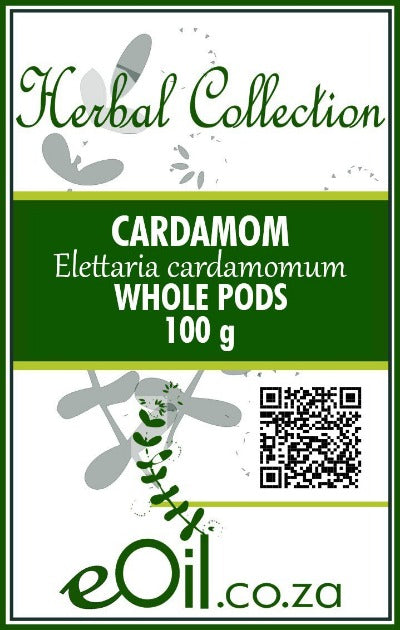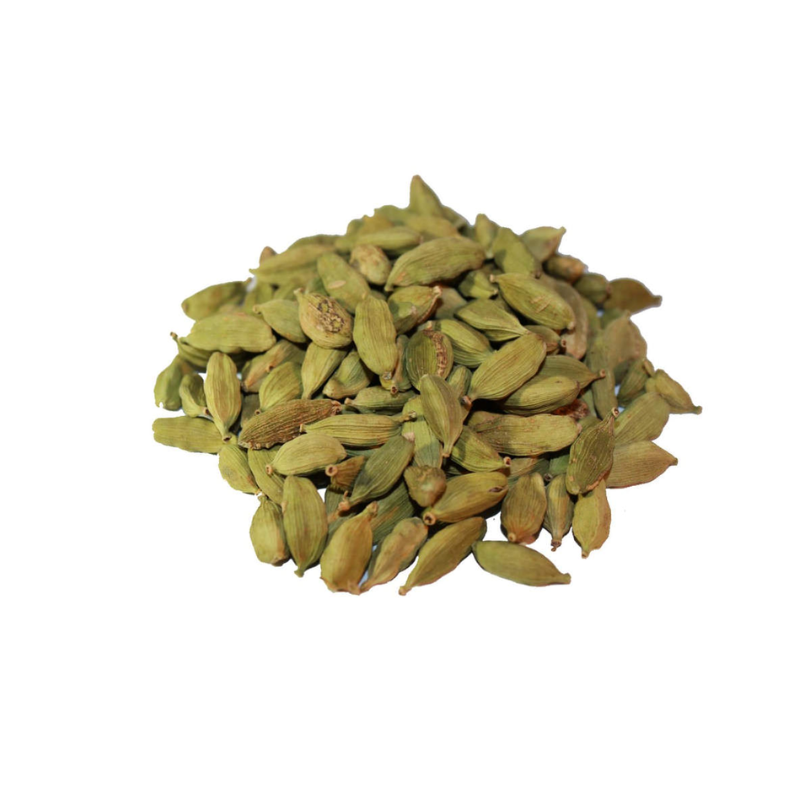Cardamom Pods Whole - Herbal Collection
Cardamom Pods Whole - Herbal Collection - 100 GR is backordered and will ship as soon as it is back in stock.
Description
Description
Cardamom Pods Whole (Elettaria cardamomum) are prized for their intensely aromatic, sweet, and slightly spicy flavor.
Used in curries, rice, desserts, and chai, they add depth to both sweet and savory dishes.
Freshly dried and packed for lasting quality—pure, natural, and additive-free
TRADITIONALLLY USED FOR
May help with
- digestion
- antispasmodic
- gasto protective
- anti bacterial
- antiseptic
- anti mycotic
- regulation of intestinal flora
- expectorant
- neuroprotective
Cardamom comes from the seeds of several different plants that belong to the same family as ginger.
It has a distinctive flavour that complements both sweet and savoury dishes. People may use cardamom seeds and pods in curries, desserts, and meat dishes, as well as in beverages, such as coffee and chai tea.
The pods that encase cardamom seeds have little flavour on their own, but they are a handy way to keep the seeds contained.
Crushing the pod slightly helps expose the aromatic seeds inside. The pods may be removed from the dish before serving, or you can just eat around them.
INFORMATION
Source : http://www.wikiphyto.org/wiki/Cardamon
Reference on http://www.wikiphyto.org
Translation in English by Google Translate (go to the page of the source linked | on Chrome cellphones go on the 3 dots on the top right and select translate in your preferred language | on laptop right click your mouse and select option translate when hoovering on the page
plant name
Cardamom, Malabar cardamom , green cardamom
International Latin denomination
Elettaria cardamomum (L.) Maton var. minuscula Burkill, Alpinia cardamomum Roxb., Amomum cardamomum L. non Roxb.
- Amomum subulatum Roxburgh is the black cardamom
botanical family
Zingiberaceae
Description and habitat
- Rhizomatous perennial plant, with white flowers with a delicate aroma and lance-shaped leaves up to 75 cm in length and 5 cm in width, 2-3 m in height
- The fruit is an elongated capsule of green color containing about ten seeds.
History and tradition
- It is one of the oldest spices
- Native to the west coast of India (Malabar Coast), in the “mountain of the cardamoms”, from 750 to 1500 m above sea level, with an annual rainfall rate of more than 2500 mm
- Used in Antiquity to make perfumes (Egypt)
- Chinese medicine panacea
- It has an intense aromatic power (one seed spices up one kilogram of food)
- Ingredient of betel quid
- Other “cardamoms”: Ceylon cardamom ( Elettaria major ), Bengal cardamom ( Amomum aromaticum ), Siamese or round cardamom ( Amomum compactum ), Chinese cardamom or bitter cardamom ( Amomum globosum )
Parts used
- Seeds
- fruit essential oil
Dosage forms available
- Essential oil
- cardamom fruit
Usual dosages
- 1.5 grams of drug
- 1 to 2 grams of tincture
- 1 drop of essential oil twice a day (40 mg)
Composition
Main components of the plant
- Essential oil 3 to 7.5% in the fruits, 4 to 10% in the seeds (120 constituents identified)
- Hydroxycinnamic acid derivatives
- Malabaricones in mace ( diarylnonadoid )
- Lignans and neolignans, triterpenes , triterpene saponosides
- Starch: 20 to 45%
- Lipids
Main components of buds or young shoots
Main components of essential oil
- Esters : alpha-terpinyl acetate 28-50%, 4-terpinyl acetate and linalyl acetate 1.6-7.7%
- 1,8 cinéole (eucalyptol) 2-44 %
- Sesquiterpénol : nérolidol 1-2 %
- Monoterpenols : linalol , borneol , terpinene-4-ol , alpha-terpinéol
- Citrals : géranial (citral a) & néral (citral b) 0,5 à 1 %
- Terpenes : 2-14% limonene , 3-5% sabinene , beta-phellandrene , myrcene , alpha-pinene , camphor , humulene , carvone , beta-caryophyllene , menthone
Properties
Plant properties
- Increases gastric and biliary secretions, gastro-protective (comparable to ranitidine) [2] , anti-gastric ulcer [3]
- Powerful antispasmodic by activity on muscarinic receptors, anti-inflammatory, analgesic [4]
- Stomachique, carminatif, stimulant
- Intestinal antiseptic, anti-mycotic
- Black cardamom is antibacterial against Staphylococcus aureus , Pseudomonas aeruginosa , Escherichia coli , Bacillus subtilis , more effective than erythomycin on the latter two [5] , green cardamom is antibacterial against Pseudomonas aeruginosa , Mycobacterium smegmatis , Klebsiella pneumoniae , Staphylococcus aureus , Escherichia coli , Salmonella typhimurium , Enterococcus faecalis , Micrococcus luteus ,Shigella flexneri , and antifungal against Candida albicans
- Regulator of digestion and intestinal flora, promotes the development of saprophytic flora to allow the development of a “bacterial shield”
- Immunomodulant [6]
Bud properties
Properties of essential oil
- Anti-inflammatory, analgesic, antispasmodic by blocking muscarinic receptors [7]
- Anti-microbial [8] , [9] , on resistant bacteria ( Escherichia coli producing β-lactamases, and Staphylococcus aureus resistant to methicillin, especially when encapsulated in chitosan nanoparticles [10] , inhibition of bacterial biofilms of Staphylococcus aureus [11] , quorum sensing inhibition in Candida albicans , Streptococcus mutans , Staphylococcus aureus , Listeria monocytogenes , Bacillus cereus , Salmonella typhimurium [12]
- Antifungal ( Aspergillus flavus ) [13]
- Increases bile secretion and gastric secretions
- Expectorante
- Chemoprotection against certain skin cancers [14]
- Neuroprotectrice [15]
Indications
Indications of the whole plant (phytotherapy)
- Gastralgia and gastritis, stomach ulcer
- Indigestion, flatulence, aerogastria
- Functional colopathy, colic, diarrhea
- Digestive spasms
- Crohn's disease
- Nervous breakdown
Indications of the bud (gemmotherapy)
Specific indications of essential oil (aromatherapy)
- Intestinal dysmicrobism, digestive spasms, colopathies, digestive candidiasis
- Nausea [16]
Known or suspected mode of action
- Metabolization of phenylpropane derivatives would produce amphetamine or mescaline -like compounds
Usual formulations
- intestinal flora regulation formula:
- EO Basil Ocimum basilicum (flowering aerial part) 0.5 gram
- HE Cardamome Elettaria cardamomum (seed) 0.5 grams
- Guar gum 2.8 grams + H2 O qs 250 ml (if necessary reduce the dosage of gum during preparation, so as to obtain a syrupy consistency)
Take a teaspoonful twice a day after lunch and dinner, in 3/4 glass of lukewarm water. Mix well before absorption. By discontinuous cures, for 20 days then 10 to 20 days per month. [17]
Regulations
- French Pharmacopoeia list A (fruit)
Possible side effects and precautions for use
- Toxic at a dose of 5 grams of walnut powder: thirst, nausea, dry mouth, dizziness, vomiting, sweating, stomach and headache, hypothermia, tachycardia, insomnia then deep sleep, delirium, hallucinations, collapse
- The essential oil is mutagenic [18]
- Avoid the use of essential oil in pregnant women and children
- Myocardial toxicity, CPK elevation
Bibliographic references
- Go↑ Bernhard, R. A., Wijesekera, R. O. B., & Chichester, C. O. (1971). Terpenoids of cardamom oil and their comparative distribution among varieties. Phytochemistry, 10(1), 177-184.
- Go↑ A. Jamal, Kalim Javed, M. Aslam, M.A. Jafri. Gastroprotective effect of cardamom, Elettaria cardamomum Maton. fruits in rats. Journal of Ethnopharmacology, Volume 103, Issue 2, 16 January 2006, Pages 149-153. PMID 16298093
- Go↑ Jamal, Anwar & Siddiqui, Aisha & Aslam, Mohd & Javed, Kaleem & Jafri, Mustahsan & Scholar, M. (2005). Antiulcerogenic activity of Elettaria cardamomum Maton. and Amomum subulatum Roxb. seeds. Indian J. Traditional Knowl. 4(3)
- Go↑ al-Zuhair H, el-Sayeh B, Ameen HA, al-Shoora H. Pharmacological studies of cardamom oil in animals. Pharmacol Res. 1996 Jul-Aug;34(1-2):79-82. PMID 8981560
- Go↑ Delivery Özge Yörüsün, Nilüfer Acar Tek, Gamze Akbulut, Osman Bozkurt. Cardamom as a functional food: antimicrobial effect. International congress on medicinal and aromatic plants « Natural and Healthy life », 2017. Gazi University Faculty of Health Sciences Department of Nutrition and Dietetics, Poster Session 10 Submission ID: 1351
- Go↑ Majdalawieh AF, Carr RI. In vitro investigation of the potential immunomodulatory and anti-cancer activities of black pepper (Piper nigrum) and cardamom (Elettaria cardamomum). J Med Food. 2010 Apr;13(2):371-81. doi: 10.1089/jmf.2009.1131. PMID 20210607
- Go↑ al-Zuhair H, el-Sayeh B, Ameen HA, al-Shoora H. Pharmacological studies of cardamom oil in animals. Pharmacol Res. 1996 Jul-Aug;34(1-2):79-82. PMID 8981560
- Go↑ Jazila El Malti, Mountassif Driss, Amarouch Hamid. Antimicrobial activity of Elettaria cardamomum : Toxicity, biochemical and histological studies. Food chemistry, 2007, vol. 104, no4, pp. 1560-1568 [1]
- Go↑ Isao Kubo, Masaki Himejima, Hisae Muroi. Antimicrobial activity of flavor components of cardamom Elettaria cardamomum (Zingiberaceae) seed. J. Agric. Food Chem., 1991, 39 (11), pp 1984–1986
- Go↑ Jamil, B., Abbasi, R., Abbasi, S., Imran, M., Khan, S. U., Ihsan, A., Javed, S., Bokhari, H., & Imran, M. (2016). Encapsulation of Cardamom Essential Oil in Chitosan Nano-composites: In-vitro Efficacy on Antibiotic-Resistant Bacterial Pathogens and Cytotoxicity Studies. Frontiers in microbiology, 7, 1580. https://doi.org/10.3389/fmicb.2016.01580 PMID 27757108
- Go↑ Cui, H., Zhang, C., Li, C., & Lin, L. (2020). Inhibition mechanism of cardamom essential oil on methicillin-resistant Staphylococcus aureus biofilm. LWT, 122, 109057.
- Go↑ Abdullah, Asghar, A., Butt, M.S. et al. Evaluating the antimicrobial potential of green cardamom essential oil focusing on quorum sensing inhibition of Chromobacterium violaceum . J Food Sci Technol 54, 2306–2315 (2017). https://doi.org/10.1007/s13197-017-2668-7
- Go↑ Kapoor, I. P. S., Singh, B., Singh, G., Isidorov, V., & Szczepaniak, L. (2008). Chemistry, antifungal and antioxidant activities of cardamom (Amomum subulatum) essential oil and oleoresins. International Journal of Essential Oil Therapeutics, 2(1), 29-40.
- Go↑ Qiblawi S, Al-Hazimi A, Al-Mogbel M, Hossain A, Bagchi D. Chemopreventive effects of cardamom (Elettaria cardamomum L.) on chemically induced skin carcinogenesis in Swiss albino mice. J Med Food. 2012 Jun;15(6):576-80. doi: 10.1089/jmf.2011.0266. PMID 22404574
- Go↑ Auti, S. T., & Kulkarni, Y. A. (2019). Neuroprotective effect of cardamom oil against aluminum induced neurotoxicity in rats. Frontiers in neurology, 10, 399. PMID 31114535
- Go↑ Jane Buckle. Clinical Aromatherapy (Third Edition) - Essential Oils in Healthcare, 2015
- Go↑ Jean-Michel Morel. Practical treatise on phytotherapy. 618 pages. Ed. Grancher, 2008.
- Go↑ S. Balaji, B. Chempakam. Mutagenicity and Carcinogenicity Prediction of Compounds from Cardamom (Elettaria cardamom Maton). Ethnobotanical Leaflets 12: 682-689, 2008. texte intégral
- Korikanthimath VS, Prasath D, Govardhana R. Medicinal properties of cardamom elettaria cardamomum. Journal of Medicinal and Aromatic Plant Sciences, 2001, 22&23, 683-685 [2]
- Korikanthimath VS, Mulge R, Zachariah TJ. Variation in the yield and quality characters of cardamom (Elettaria cardamomum) clones. Journal of Medicinal and Aromatic Plant Sciences, 1997, 19, 1024-1027.
- Bruno Marongiu, Alessandra Piras, Silvia Porcedda. Comparative Analysis of the Oil and Supercritical CO2 Extract of Elettaria cardamomum (L.) Maton. J. Agric. Food Chem., 2004, 52 (20), pp 6278–6282
CAUTION
Store in a cool, dry place, away from light. Keep tightly closed, away from the reach of Children and pets.
Do not exceed the daily dose.
This product is not intended to prevent or cure any form of illness or disease.
If you are pregnant or nursing ; If you have a medical condition or are in the course of medical treatment ; If you are programmed for theater/operation in the near future, please consult your healthcare practitioner before using this product.
This product cannot replace a varied and balanced diet and a healthy lifestyle.
This product has not been evaluated by the SAHPRA for its quality, safety or intended use.
For More Information please check our General Safety Herbal products Page






